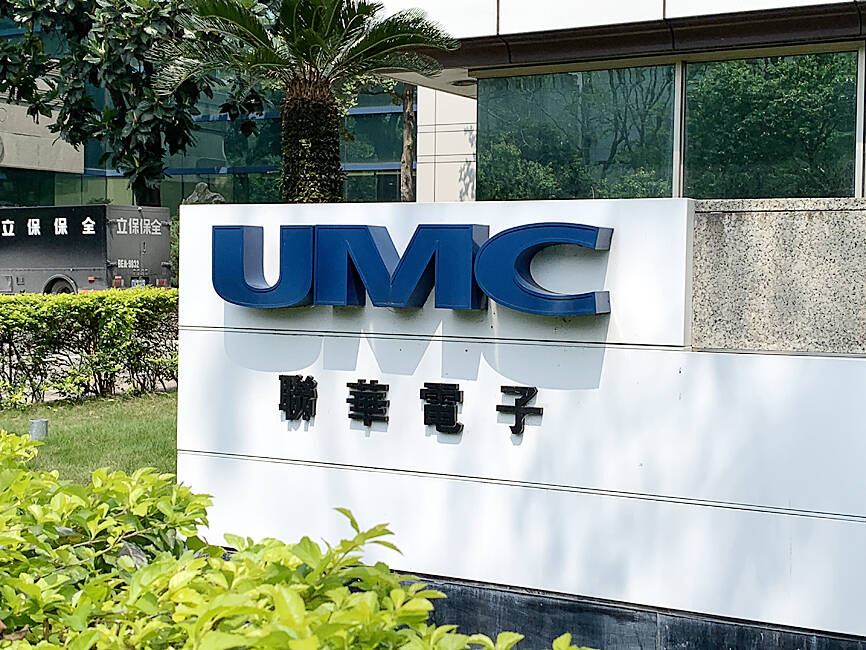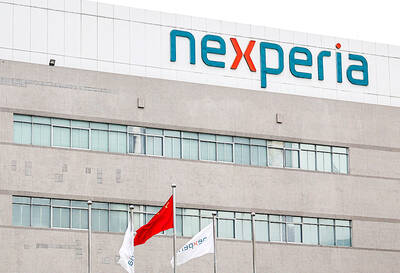United Microelectronics Corp (UMC, 聯電), the world's No.3 foundry service provider, forecast that its wafer shipments this quarter would grow up to 7 percent sequentially and the factory utilization rate would rise to 75 percent, indicating that customers did not alter their ordering behavior due to the US President Donald Trump’s capricious US tariff policies.
However, the uncertainty about US tariffs has weighed on the chipmaker’s business visibility for the second half of this year, UMC chief financial officer Liu Chi-tung (劉啟東) said at an online earnings conference yesterday.
“Although the escalating trade tensions and global tariff policies have increased uncertainty in the semiconductor industry, we have not seen market demand change in the very near term,” Liu said. “Some customers are sidelined and want to take some precautionary action, but there are some customers doing the opposite. So the net-net impact for the second quarter is very limited.”

Photo: Grace Hung, Taipei Times
UMC did receive customers’ requests to accelerate its new 12-nanometer capacity expansion in collaboration with Intel Corp, as the tariff environment and escalating geopolitical tensions led to increasing reshoring interest, Liu said.
“I think most of the customers want to see the 12-nanometer solution as early as possible. They also have a very aggressive product launch time, and hope our 12-nanometer solution can catch up with their product roadmaps,” Liu said.
Since UMC has set an aggressive timeline for the US capacity expansion, “we are on track with our planned schedule,” he said, meaning that UMC would ramp up 12-nanometer chip production in 2027 at Intel’s manufacturing facility in Arizona.
However, the company refuted speculation that it was in talks with GlobalFoundries Inc to form a joint venture to avoid the US’ semiconductor tariffs.
“There’s no ongoing so-called merger activity right now,” Liu said. “But it doesn’t have to be mergers. There are many other collaborations we can still pursue to enhance shareholders’ value and returns.”
UMC yesterday reported its lowest profit in about 19 quarters, as net profit last quarter declined 8.5 percent quarterly and 25.6 percent annually to NT$7.78 billion (US$239.4 million). Earnings per share sank to NT$0.62 from NT$0.68 in the prior quarter and NT$0.84 a year earlier.
The company expects gross margin this quarter to bounce back to about 30 percent, compared with 26.7 percent last quarter, without the impact of one-time pricing reductions that usually happen at the beginning of a year.
The growing demand for chips used in communications, computers and consumer electronics is expected to drive up the factory utilization rate this quarter, compared with 69 percent last quarter, UMC said, although it remains conservative about demand for chips for cars and industrial devices, given excessive inventory.
For the whole of this year, UMC said it would grow its revenue by more than 3 percent, outpacing a low-single-digit percentage increase for the world foundry sector.

JITTERS: Nexperia has a 20 percent market share for chips powering simpler features such as window controls, and changing supply chains could take years European carmakers are looking into ways to scratch components made with parts from China, spooked by deepening geopolitical spats playing out through chipmaker Nexperia BV and Beijing’s export controls on rare earths. To protect operations from trade ructions, several automakers are pushing major suppliers to find permanent alternatives to Chinese semiconductors, people familiar with the matter said. The industry is considering broader changes to its supply chain to adapt to shifting geopolitics, Europe’s main suppliers lobby CLEPA head Matthias Zink said. “We had some indications already — questions like: ‘How can you supply me without this dependency on China?’” Zink, who also

At least US$50 million for the freedom of an Emirati sheikh: That is the king’s ransom paid two weeks ago to militants linked to al-Qaeda who are pushing to topple the Malian government and impose Islamic law. Alongside a crippling fuel blockade, the Group for the Support of Islam and Muslims (JNIM) has made kidnapping wealthy foreigners for a ransom a pillar of its strategy of “economic jihad.” Its goal: Oust the junta, which has struggled to contain Mali’s decade-long insurgency since taking power following back-to-back coups in 2020 and 2021, by scaring away investors and paralyzing the west African country’s economy.

BUST FEARS: While a KMT legislator asked if an AI bubble could affect Taiwan, the DGBAS minister said the sector appears on track to continue growing The local property market has cooled down moderately following a series of credit control measures designed to contain speculation, the central bank said yesterday, while remaining tight-lipped about potential rule relaxations. Lawmakers in a meeting of the legislature’s Finance Committee voiced concerns to central bank officials that the credit control measures have adversely affected the government’s tax income and small and medium-sized property developers, with limited positive effects. Housing prices have been climbing since 2016, even when the central bank imposed its first set of control measures in 2020, Chinese Nationalist Party (KMT) Legislator Lo Ting-wei (羅廷瑋) said. “Since the second half of

Taiwan Semiconductor Manufacturing Co (TSMC, 台積電) received about NT$147 billion (US$4.71 billion) in subsidies from the US, Japanese, German and Chinese governments over the past two years for its global expansion. Financial data compiled by the world’s largest contract chipmaker showed the company secured NT$4.77 billion in subsidies from the governments in the third quarter, bringing the total for the first three quarters of the year to about NT$71.9 billion. Along with the NT$75.16 billion in financial aid TSMC received last year, the chipmaker obtained NT$147 billion in subsidies in almost two years, the data showed. The subsidies received by its subsidiaries —